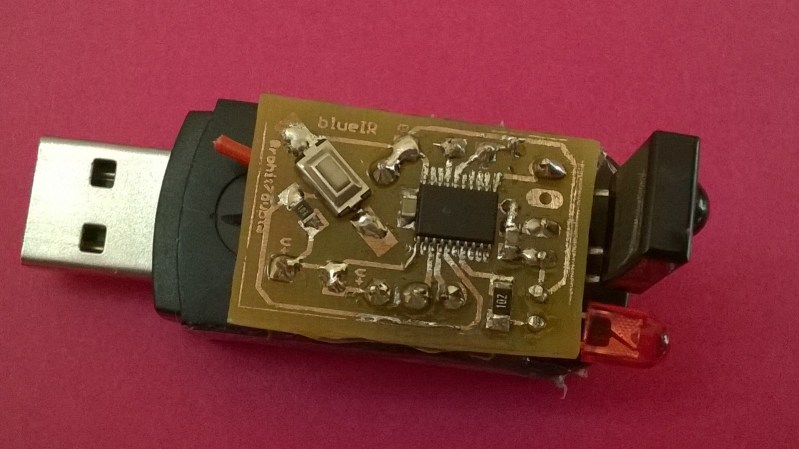Quite often, the raison d’être for building a project is to learn and hone one’s skills. In which case it doesn’t matter if the end use seems a bit frivolous. [indiantinker] built BlueIR, a device to control Bluetooth A2DP devices using an archaic IR Remote using a BT-Aux Adapter.
Sounds convoluted? Let’s try again. He uses an old IR remote to send data to a MSP430-series microcontroller, which is connected over serial to a USB Bluetooth Receiver Adapter, which in turn is connected to a set of wired speakers. The Bluetooth adapter is paired with his phone. The IR remote allows him to control the audio player commands on his phone from a far greater distance compared to the bluetooth adapter.
He begins by breaking open the BT adapter to find that the markings on the chip have been erased. What he did find instead, were two pads promisingly marked as TX and RX, but he still did not know the baud rate or the command set. Digging around the Internet, he figured out that the chip used was the OVC3860 Bluetooth 2.0 + EDR Stereo Audio Processor and found its list of AT Commands. After some tests using a serial console he figured out that it worked at 115600 baud. Soon enough, he had it hooked up to the MSP430 Launchpad and was able to communicate. Next up, he built a small PCB, using the toner transfer method. The board consists of the MSP430G2553 micro controller, IR receiver, LED, some decoupling capacitors and a few pull up resistors. He leached power from the 3.3V regulator on the host BT adapter. The assembled PCB is piggy backed on top of the BT adapter for the time being, and a 3d printed housing is on his to-do list. His code is available at the BlueIR Github repo and the video below shows it in action.















This project is not frivolous at all. It has a practical purpose. Why would you use that as your opening sentence?
Guarding against negative comments, no doubt. It may seem frivolous at first glance to some folks, unless you’ve had need for such a bridge – then it’s not frivolous at all.
bridge, gateway (the term I would give it) – its all good ;)
but its more of a gateway since it really translates the intent of something into a very different output request data format. same intent but way different ‘payload’ formats. so to me, its not bridging but its gatewaying.
using IR remote as a control item makes some sense. they are great on batteries, you can buy universal remotes for cheap, they are easy to buy, some are learning by IR but the ones that are preferred for ‘maker projects’ that use this library (that I assume he’s using, the ken schiriff (sp?) version) are the ones where you can enable a sony device (tv or cd/dvd) and then have the ‘ken’ library decode it, print the number and you use that as a switch-statement constant (like rohit did) to be used to do some task via another control protocol. sony IR protocol seems so damned robust and works even bouncing off walls, I usually pick that first over the other types (nec, rc5, 6, etc). also, there is no RF interference in IR. even if you have a ton of rf devices in the room, you can still aim IR at a receiver and it will get thru.
I just finished a quick project that scans the IR receiver and sends out xbee messages to some other xbee peer. so, I’m hip with the ir-to-something gateway concept ;)
I dont think it’s frivolous, In the ye’ olde days I used to use PDAs as an all in one remote for all equipment in the house. They were bad ass at it with custom UI per appliance etc… then smartphones came in and ruined all the fun. I would love to see IR make a comeback in devices and laptops.
IR remote are great to buy. They got good battries and very cheap
Nice Hack.
I only recently came across these USB-bluetooth-3.5mm adapters on Aliexpress. They’re less than $2.50!
Great hack, this guy know about protocols, but theses Bluetooth adapters make a constant chirping noise (Interference) when connecting to the phone and playing, it is any way to fix this?